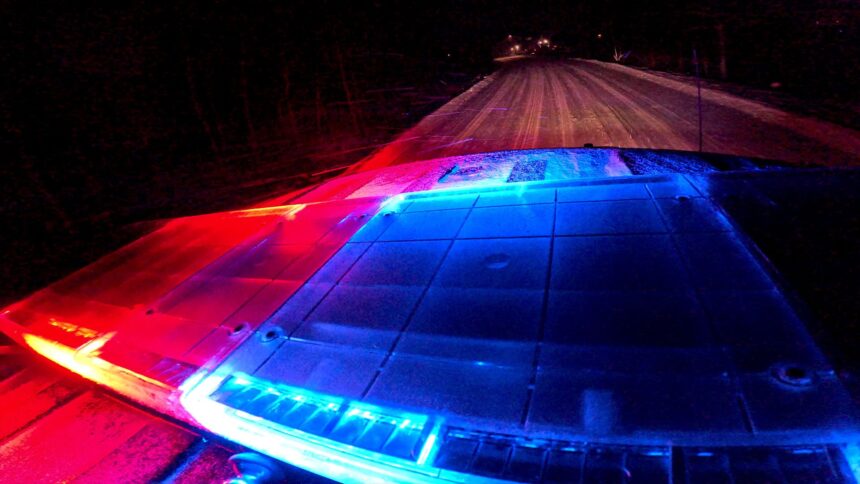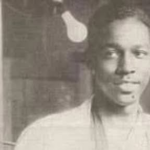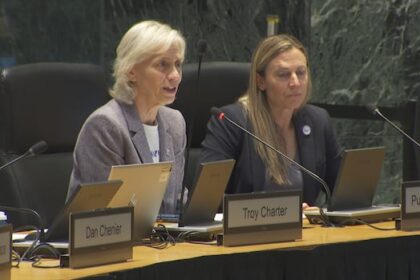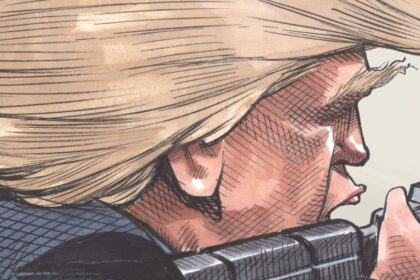The headlights from the truck that Anishinabek Police Services [APS] Constable Chris Palmer is driving cut through the shadows in the tree-lined country road ahead. The silence is broken by the crackle of the police radio coming to life. Palmer and his partner, Const. Logan Lewis make their way to the southern section of Netmizaaggamig Nishnaabeg First Nation. “I like policing my own community,” says Lewis, 29, from the passenger seat. “I do care about what happens here. It’s kind of hard to turn it off when I’m not working.” This is Lewis’s third month policing the community of about 400, which is also known as Pic Mobert First Nation, located 370 km east of Thunder Bay, Ont. Palmer, 33, turns off the gravel road into a more residential part of the reserve. Cascading yellow light from sparsely spaced street lamps begins to fall through the windshield to briefly light up Palmer’s face. The Ojibwe/Cree father of three has been patrolling Netmizaaggamig Nishnaabeg for three years. He and Lewis are on their way to do a compliance check on a man who has conditions to remain at home between 10:00 p.m. and 6:00 a.m. “We are more community-based, so we understand the struggles that our community members are going through, so we take that into account,” says Palmer. “As long as no one is in danger, if there’s a curfew issue, we would look past that if it’s for ceremony or treatment, whereas a lot of non-First Nations [police] services are more cut and dry.” Still, when Palmer stops in front of the man’s residence, there’s a sense of relief. “Heeeyyyy, there he is,” Palmer says, gesturing to a silhouette figure darkening a backlit doorway. Lewis gets out and approaches the figure, who looks to be in his 20s. It’s almost 11:00 p.m. on the last day of November 2024, about halfway through Lewis and Palmer’s overnight shift. “Just making sure you’re all good,” Lewis says to the man, who agrees to be recorded provided his identity is withheld. “I knew you’d be good, but the new sergeant wanted to come down.” As if on cue, Sgt. Fiona Duncan pulls up in a separate APS vehicle and gets out. Duncan, 53, isn’t so much interested in checking up on folks as she is in getting to know them. “How’s it going, you the new sergeant?” asks the man, who will be known as Greg in this article. “I’m the new sergeant, I’m Fiona,” confirms Duncan, reaching out to shake Greg’s hand. “Nice to meet you. You’ll probably get to know me pretty well there,” Greg says in an attempt at humour that comes across as a little too truthful to be funny. “I hope not,” replies Duncan. “I hope not either, but…” Greg says, searching for words. “I hope so, but I hope not in a bad way, right?” Duncan concludes with a tinge of hope. It’s the kind of conversation two players from opposing teams would have after a chance encounter in between games. Sgt. Fiona Duncan of the Anishinabek Police Service. Photo: Tom Fennario/APTN. Greg’s barking dog comes running down the street, interrupting their conversation about how the conditions of Greg’s release could be adjusted if he goes to get treatment for addiction about four hours west in Thunder Bay. “Baby girl, get inside,” Greg pleads with the dog. Despite Greg’s appeals, the dog keeps barking and refuses to go inside. Meanwhile, Greg is all too aware that if he were to leave the doorway he’s standing in to go get the dog, he’d technically be breaking the law with three officers watching. “She’s trying to lure you out!’ quips Lewis, making Greg and the other officers laugh. For the Netmizaaggamig Nishnaabeg APS detachment, it’s a moment of levity in a job where laughs can be few and far between. Like in many communities across the country, the drug crisis is growing. Out-of-town drug dealers from the south have been coming to Netmizaaggamig Nishnaabeg, bringing with them addiction and violence. 2024 saw stabbings, home invasions and assaults On Nov. 19, the band council declared a state of emergency over organized crime, addiction, and violence. Ten days later, Duncan started her first weekend working overnight shifts here. Recently promoted, she’s come to Netmizaaggamig Nishnaabeg after nearly seven years of patrolling, mainly at the Fort William APS detachment. “I absolutely understand why people are frustrated. I mean, there has not been enough police presence in this community,” Duncan says while driving around between calls. “We don’t have enough bodies to work 24 seven. It’s not fair to the communities that we police, and it’s not fair to the officers.” In Ontario, APS polices 16 First Nations, with some of the detachments serving multiple communities. Until recently, the APS detachment serving Netmizaaggamig Nishnaabeg was based at Biigtigong Nishnaabeg (aka Pic River First Nation), meaning it could sometimes take 45 minutes or more for APS to respond to emergency calls in Netmizaaggamig Nishnaabeg. As a result, the detachment has been given office space in the Netmizaaggamig Nishnaabeg family services building. “I’m really hoping that it just raises our visibility in the community because then we’re not split between the two communities, right?” says Duncan. While Duncan is grateful to the band council for pulling a space together quickly, she says it lacks things that police stations should have, such as a place to detain people who have been arrested and a space to safely load and unload weapons. Also, on one of the nights APTN Investigates rode along with Duncan, she was driving a borrowed OPP truck because the detachment was down a vehicle. “There’s a long history of Indigenous police services being underfunded, understaffed, not having adequate equipment. And I just think there’s got to be an end to that,” says Duncan. Const. Logan Lewis of the Anishinabek Police Service. Photo: Tom Fennario/APTN. Duncan comes across as an affable, roll-with-the-punches kind of person, but she says constantly making do with less takes a toll on her and her team. This night shift coincides with the 11th day since the state of emergency was called. Duncan and her colleagues are making a point of “flying the colours”, that is, making their presence felt by patrolling more instead of waiting for calls to happen back at the office. The idea is to not only make community members feel safer but also send a warning to anyone with bad intentions. “I understand that when people call us, they’re probably not having the best days,” says Lewis. “It’s not them that we’re dealing with, it’s just them when they’re having a bad time. And that’s why we’re called, because unfortunately nobody calls the police when they’re having fun.” “I grew up around policing,” says Palmer. “My dad was a police officer since 1992. Everyone, or all the older generation for sure, remembers my dad, remembers the type of person he was and what he did for the communities.” While Palmer is proud of his father’s legacy, he says he’s a little tired of getting grief for being perceived as less forgiving than his dad. “Yeah, I definitely get a lot of flack, but my main goal is still to help people. You know, sometimes you have to arrest people. That’s the job. And I try to treat everyone with respect and dignity,” says Palmer. Palmer and the APS team try to practice what’s referred to as community policing, where they aim to form trust and partnerships with the community to help make it safer. This can lead to strange dynamics where they arrest people like Greg, since they’re are also the ones who reach out to try to keep him out of further trouble. Palmer says that community policing was easier in his dad’s day when the crime rate wasn’t so high and the lack of manpower wasn’t so crippling. Constable Chris Palmer of the Anishinabek Police Service. Photo: Tom Fennario/APTN. For example, before checking on Greg, Palmer and Lewis stopped by the home of a woman who, hours earlier, called in to report she was being threatened. While the intention is there, she is not home and they are too late to do anything about the alleged threat because there was no officer on duty when she called. “And then another big issue is that not a lot of people have phones here, so they’re hard to track down,” adds Lewis, alluding to the absence of cell reception in the community. The lack of manpower is the kind of thing that makes community policing harder by diminishing public trust in the APS. It also frustrates officers to no end. “You could basically work around the clock if you wanted. It’s not really healthy for the officers to be operating like that. I know some officers that do 20-to-30-hour shifts,” says Duncan. Duncan says that when you only have three officers to police a community struggling with social issues, burnout can occur. Officers don’t have back up for dangerous situations, with crimes going unpunished or even unreported. “We need to be here to serve our communities. No different than any other police service in the province or in the country,” says Palmer. APS police chief Jeff Skye says the lack of police services is the result of Canada’s inaction. “There’s been very minimal investment in First Nation policing in over 30 years,” says Skye during a news conference at the Assembly of First Nations (AFN) special assembly in December. “Our officers and civilian staff are asked to do more with less. And our community members suffer the consequences.” Unlike other police in Canada, Indigenous police services are not legally considered an essential service. This means that every few years they have to fight Canadian and provincial governments for every dollar while renegotiating agreements. And they say rarely do they get enough to do their jobs. “We’re decades away from fixing it now,” says Skye. “It’s not on us, it’s on Public Safety to fix this. And they’re refusing to fix the funding.” The issue has been the subject of many reports, including one from the National Inquiry into Missing and Murdered Indigenous Women and Girls. The report’s calls for justice 5.4 states, “Indigenous police services must be funded to a level that is equitable with all other non-Indigenous police services in this country.” “They tell us how many officers we need in our communities,” says Skye with growing frustration in his voice. “Whereas any other police service, they put a proposal in, ‘this is how much we need based on our crime, our calls for service.’ And we do the same thing and to no avail.” Skye is a part of the Indigenous Police Chiefs Association of Ontario, who filed a human rights complaint against Public Safety Canada concerning funding First Nations policing. Among other things, the complaint accuses the federal government of “deliberate and wilful discriminatory conduct and amounts to systemic discrimination.” Dwayne Zacharie is the longtime police chief of the Kahnawake Peacekeepers and the vice president of the Quebec Association of First Nation and Inuit Police Directors. Photo: Tom Fennario/APTN. It also alleges that Canada uses bad faith negotiation tactics, such as presenting pre-written funding agreements that have little to no input from the First Nation, as well as waiting until the last moment, or even after the previous agreement expired, to negotiate. “For some communities, you know, like the last minute, they don’t have time to say ‘no’ sometimes,” says Dwayne Zacharie, who for 21 years has been chief of the Kahnawake Peacekeepers as well as being the current vice-president of the Quebec Association of First Nation and Inuit Police Directors. “And sometimes they’re signing an agreement that may not be better and it may not give them what they require, but they have no choice because they have to keep the lights on and they have to keep the door open. “Why are we always getting put on the back burner? Why are we always kind of regarded with this benign neglect attitude? We are still regarded as a program. So basically, what that means is however long our policing agreements are signed for, that’s as long as we exist.” Zacharie is referring to the First Nations and Inuit Policing Program. Created in 1991 and last updated in 1996, the program’s purpose is to fund police services in Indigenous communities. It currently funds 36 Indigenous police services, which cover 155 communities mainly located in Quebec and Ontario. Fifty-two per cent of the funding comes from the federal government, with the remaining 48 per cent being provided by the province or territory. “First Nation policing exists for pennies on the dollar in comparison [to other police services],” adds Zacharie. “We need to be recognized for the services that we provide.” Indigenous police chiefs aren’t the only ones sounding the alarm In February of 2024, the Auditor General of Canada released a damning report finding that Public Safety Canada’s handling of the funding program had poor financial management, a limited expansion of the program despite additional funding, and a lack of consistent partnership with communities. “Our community is being grounded down by systemic neglect, chronic underfunding of essential services, and a paralyzing lack of action from those with the power and resources to help,” says Louis Kwissiwa, chief of Netmizaaggamig Nishnaabeg. “We need Canada and Ontario to stop passing responsibility back and forth and take action.” Kwissiwa’s point about provincial and federal responsibilities is raised in the auditor general’s report where it’s stated that Public Safety Canada “relied on the provinces’ or territories’ readiness to fund their share of the program.” This means that when it comes to funding, Canada lets the provinces, which have jurisdiction over policing, set the funding benchmark. In a response to the auditor general that APTN obtained through access to information, Public Safety Canada wrote that “…the audit itself was structurally limited by excluding the role of the provinces and territories in the design and delivery of the First Nations and Inuit Policing Program.” Some say, the provinces are discussing the issue. “As far as the provinces go or the province of Quebec, for that matter, we haven’t had very many meaningful, in-depth discussions about what First Nation policing would look like as an essential service,” says Zacharie. In 2021, former prime minister Justin Trudeau gave Public Safety Canada a mandate to create legislation to make Indigenous policing an essential service. It would mean more consistent, flexible funding to address First Nations and Inuit specific needs. “Becoming recognized as an essential service, it may not solve all of these problems,” says Zacharie, “but it will definitely put us in a better position to be able to address the issues that are happening within our communities.” But after more than three years of consultations and reports, the legislation remains stalled and the government blew past its 2023 goal of tabling legislation. Public Safety Canada and First Nations policing Meanwhile, documents obtained through access to information show Public Safety Canada trying to strike an uneasy balance between provincial and First Nations’ concerns. In a 2023 draft document outlining guiding principles of the legislation to First Nation chiefs, Public Safety Canada says, “The intent of the legislation is to support First Nations on their distinct paths to self-determination and self-government.” Also in 2023, after the AFN called the proposed legislation restrictive for not recognizing First Nation’s full jurisdiction over policing, Public Safety Canada suggested a workaround on the sovereignty issue. In a letter to then national chief RoseAnne Archibald, Public Safety Canada affirmed that they were ” prepared to hold exploratory discussions on self-determination and First Nations jurisdiction over community safety and security via a separate process.” Chief Louis Kwissiwa of Netmizaaggamig Nishnaabeg First Nation attended the AFN Special Assembly in December to raise awarness of policing issues in his community. Photo: Tom Fennario/APTN. But in February 2024, a memo to the minister of Public Safety says that provinces and territories need to be assured that “The scope of the mandate does not include recognizing First Nations inherent rights and jurisdiction over policing.” “The federal government, the provinces, they need to recognize and they need to make changes to their policies to be able to adapt to what our needs are. They need to make the changes, not us. We don’t need to change. We don’t need to give up sovereignty,” says Zacharie. Public Safety Canada declined to do an interview for this story. In a written statement they say “The government of Canada has heard the need for reforms to the First Nations and Inuit Policing Program (FNIPP) and is committed to continuing to improve the program.” Public Safety points to $200 million over five years they added in 2024 to improve police infrastructure, which has led to new police stations being built in First Nations such as Lac Simon, Kebaowek, and Listuguj. When asked about addressing First Nations’ concerns about jurisdiction over policing via a separate process from essential service legislation, Public Safety says they will “… continue to evolve through negotiations of self-government agreements and via the development of the Indigenous Justice Strategy.” A sacred fire and the community In the meantime, Indigenous communities are going to have to make do. “With the lack of policing, we have to take matters into our own hands to bring some type of security to our First Nation,” says Chief Kwissiwa. Kwissiwa says his community has incurred five million dollars of debt the last few years paying for things like private security, security cameras, and license plate readers. Money he would’ve rather spent elsewhere. “Funding for education, adequate homes, good addiction programs, recovery centers. We need all of that. We have the capacity to do it. We’re not asking the federal and provincial government to fix it for us. We’re asking them to help us because we can do it,” Kwissiwa says. Netmizaaggamig Nishnaabeg has taken steps to address the root causes of the social issues in the community. More housing has been built. Trained community support personnel from an Indigenous majority owned company help provide front line support. A new modular building for the APS team is also in the works. But at the end of the day, Kwissiwa says that before they can address the intergenerational trauma at the root cause of the social issues, there needs to be a sense of order and security in the community. “Every community, First Nation, municipality across Ontario and Canada deserves adequate policing. First Nations are not getting it. Netmizaaggamig Nishnaabeg is not getting it. We need that and we deserve it as well,” says Kwissiwa. “Can’t fix a wound if it’s still bleeding, right?” Following their compliance check on Greg, Duncan, Lewis, and Palmer drive to other side of the railroad tracks that cut across the community. There, a sacred fire is burning for a community member who recently died due to suspected complications of drug use. Duncan and Palmer were the ones who made the next of kin notification the night before. And while it’s always been a part of the job, telling a parent about their child’s death has become far too common during the drug toxicity crisis. Not just in Netmizaaggamig Nishnaabeg, but everywhere. It may often be difficult, but Duncan says building relationships with people is her favourite part of the job. “Sometimes you don’t meet them at the best time in their life and you kind of want to turn that around for them and try, what? What can you do to try to turn this moment around for them?” asks Duncan rhetorically. “From an initial terrible incident that somebody suffers, I think it’s important in building that relationship to follow up with them, like when they’re having a good moment.” This may not qualify as a “good” moment, but Duncan, Lewis, and Palmer take some time to stand by the sacred fire with a couple of other community members. As they chat, the fire diminishes to an orange glow, waiting. A log is tossed on and the APS team heads back to their vehicles. It won’t be long before the fire starts blazing again. Continue Reading
Essential Service: The hidden cost of underfunding Indigenous police services

Leave a Comment









